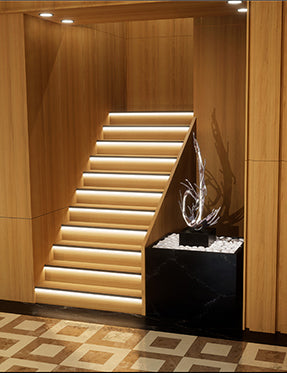Abstract:
In recent years, more and more people are choosing to install stair with lights as they are becoming more conscious of the safety and style of their homes. However, there are so many types of step lighting, and why are strip lights so popular for decorating steps?
The disadvantage of other stair step lights.
Traditional stair lights, including recessed, surface-mounted, and wall-integrated fixtures, have some limitations, such as:
- Uneven lighting: These step lights often produce a point source of light, leaving dark areas between fixtures that can affect visibility and safety.
- Complicated installation: Installation of these stair lighting can be labor-intensive, requiring cut-outs in walls or steps and complicated wiring, which increases installation costs. Or when you want to install stair lights after you've lived in the house for a while, recessed stair lights indoor can add significant labor and installation costs and time.
- Limited design flexibility: They come in fixed shapes and sizes, making it difficult to accommodate unique or curved step designs.

Therefore, why use strip lights as staircase lights?
Why use strip lights as step lights indoor?
- Continuous and even illumination
One of the best things about LED light strips is that they can provide a nice, even glow all the time. Unlike traditional step light, which can sometimes create light spots and shadows, LED light strips provide a lovely, uninterrupted light. This lovely, even light shows off the edges of the steps perfectly, which makes it much safer and reduces the risk of tripping or falling, especially in dimly lit areas.
- Flexible customized design
LED strip light comes in a variety of lengths and can be cut or bent to fit any length and shape. When dealing with irregular or curved step designs, this flexibility adapts to a wide variety of materials and designs of stairs to meet any of your needs.
- Aesthetics
Another major advantage of the strip LED lights is its unobtrusive design; unlike traditional stair light, which has to be left in place and placed in a more conspicuous part of the staircase when you are planning to decorate your house, it can be mounted discreetly at the edge or bottom of the steps without detracting from the design of the steps themselves.
- Energy efficiency and long life
LED lights strip lights are known for their energy efficiency and long life. They consume much less power than many traditional step lights and have a lifespan of 50,000 hours or more, reducing the need for frequent replacement.
- Easy to install
Strip lighting comes with an adhesive backing, which allows them to be mounted on stairs of any material and shape. Its adhesion is very strong without harming the stairs, which is very easy to use and can be installed without any professional help.
- Intelligence
Equipped with motion sensing, the LED step lights automatically sense your movement and lights up when a person walks to the top or bottom of the staircase and turns off when the person leaves. Automotive strip lighting also provides 12 lighting operating modes and adjusts the time, brightness and speed as needed to meet your lighting needs.
How to choose a suitable LED lighted staircase?
A suitable staircase lighting indoor is very important to fit your decoration and home, such as a cozy togo sofa and minimalist decor.
When choosing staircases with lights based on color temperature, it's important to understand how different color temperatures affect the ambiance and functionality of a space. 2700K to 3000K warm white staircase lights create a soft, warm, and cozy ambiance, making them ideal for living rooms, bedrooms, and dining areas that require a cozy atmosphere.
In contrast, neutral white light (typically between 3500K and 4100K) provides balanced illumination that is neither too warm nor too cool, making lights for a staircase suitable for kitchens and work areas where a natural feel is desired.
For areas that need brighter, more focused light, cool white options (4000K to 5000K) provide a clear, bright light that is ideal for bathrooms, garages and task-oriented spaces to improve visibility and alertness.
Daylight color temperatures, ranging from 5000K to 6500K, closely resemble natural daylight and are best suited for retail spaces, display areas, or environments where color accuracy is important.
So, when choosing the right color temperature, it is important to consider the primary use of the space; for example, warm whites are good for lounge areas, while cool whites are more appropriate for work areas.


